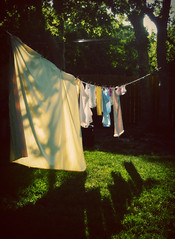
Washing your clothes in cold water vs. warm water not only saves energy but also saves you money. 90% of the energy used for washing clothes is for heating the water.
If I have a tuff stain, like my daughters soccer uniform, I will soak it in a small bucket with arm & hammer baking soda for a few hours, then toss it in the wash. I have also heard that vinegar and peroxide is another great stain fighter. Haven't tried them yet. After my clothes are done washing I hang them on the line outside to dry. I love the smell of line dried clothes. If you don't have a line outside you can use clothes racks or hang them in the shower. On rainy days this works well too.
In the winter time I hang my clothes on racks and put them by my wood stove. They are usually dry with two hours. Hanging your clothes up takes a little bit of planning but in the long run it saves you money and saves your clothes. The dryers like to eat your clothing. Where do you think all that link comes from?
Seventh Generation is having a 7 day laundry challenge. They are challenging you to hang up your clothes for 7 days. Come join my in the challenge. They have a calculator that can tell you how much money you can save a year. I'm saving $46.52 yearly.
What you can do to help save energy:
-Set your temperature control to cold.
-Use cold water detergents. They leave your clothes as clean as warm water detergents.
-Wait until you have a full load or adjust the water level to a lower setting.
-Line dry your clothes.
-If you are looking at replacing your washing check out energy star.
Taking small steps like washing in cold water or line drying your clothes makes a huge impact on our environment. Thanks for all your help.

Reusing my plastic water bottles is one of the ways I'm helping my environment and my wallet. The U.S. is the world's largest bottled water consumers. I use my tap water to fill my plastic bottles. If your tap water isn't very tasty try the Brita filter pitchers. They are around $9- $15.
I keep 10 -15 water bottles filled at a time in my refrigerator crisper drawer. Then when anyone wants a bottle of water, they are cold and ready to enjoy. I wash them out after each use, just as if I were washing a cup. Then refill and back in the refrigerator.
Refilling water bottles with your own tap water saves you money also. The average price for a 16.9 oz. water bottle is anywhere from $0.15 - $1.69 a bottle. The average price of tap water is $1.50 for 1,000 gallons-less than a penny a gallon. A big savings. $$$$ I will buy a 20 pack of water bottles for $3.00 and reuse. When it's time for them to be disposed of they go into the recycling bins.
Another method is to buy reusable water bottles. You can get them in all different colors and sizes. Some of them are a little out of my budget. I think they would be good for a bigger family so everyone could have their own bottle. With just my daughter and I, this method works well for us.
My goal is to help reduce the waste that humans make. Click here to find ways you can help.
Let us know your reduce, reuse, recycle stories.